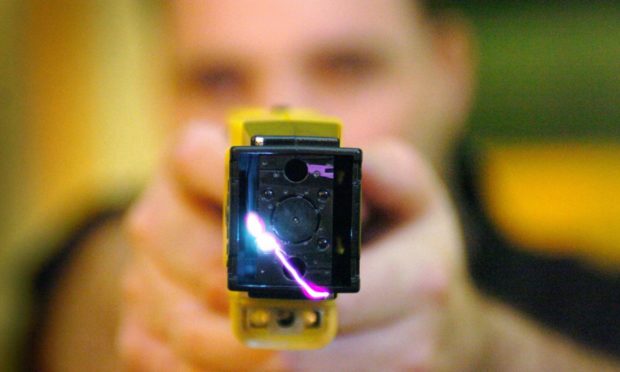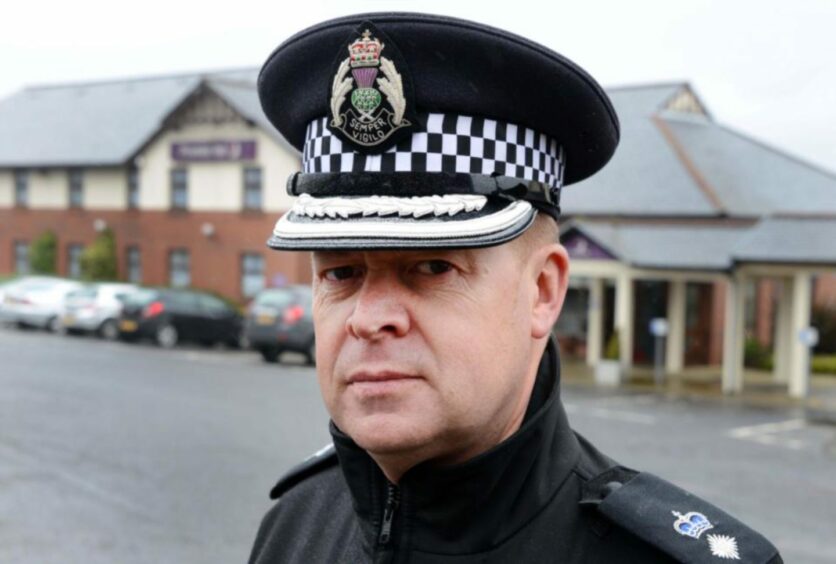Assaults on Tayside police officers have been reported every day on average for the past three years, new figures reveal.
Data from the force’s internal HR systems show officers in the region self-reported 1,167 assaults between April 1 2019 and March 8 this year, the equivalent of more than one a day.
This is the third highest total in Scotland after Lanarkshire and Greater Glasgow.
The number of attacks reported in Tayside has also increased from 340 in 2019/20 to 435 in 2021/22 – a rising trend mirrored in all 13 of Scotland’s police divisions.
Based on divisional staff numbers for March, the region also has the third highest assault rate per 100 officers after Lanarkshire and Forth Valley.
Kicking, punching, spitting and headbutting were among the most common types of assault in Tayside during the past year, with four reports involving a sharp or bladed weapon and 15 with objects being thrown.
Police with Tasers to increase
The stats, obtained under freedom of information laws, show police across Scotland have reported just over 10,000 assaults in the past three years, rising from 2,580 in 2019/20 to 4,317 in the latest annual period.
Scottish Police Federation chairman, David Hamilton, said: “These are truly shocking figures and underpin the dangers that police officers face in their daily duties – police officers who are mothers, fathers, daughters and sons, police officers who have taken an oath to protect their communities.
“For a number of years, Tayside figures have been some of the highest and we need to understand if this is related to poverty, drugs or just a preponderance to violence towards police officers.
“What is clear though is that police officers need to see the roll out of Tasers accelerated and expanded, more deterrent sentences and of course, an increase in police officer numbers.”
Chief Constable Iain Livingstone said the number of specially-trained officers who carry a Taser will rise from around 500 to 2,000 in the next three years.
The police chief said this followed a strategic risk assessment which identified in recent years, there has been a gradual but sustained increase in the number of assaults on officers and staff in Scotland, along with a rise in incidents involving weapons.
Violent Forfar assault
In January, Dundee Sheriff Court heard Forfar thug Connor Collins smashed one police officer’s ankle so severely during a struggle his foot was left facing the wrong way and he required emergency surgery.
The court heard that PC John Annand’s confidence had been so badly dented by the incident, he had been off work for months as a result.
Collins walked free from court after a sheriff was told he had expressed remorse and insight into the consequences of his actions and it was not the accused’s intention to break the officer’s ankle.
Collins was placed on a curfew for six months, ordered to carry out 180 hours of unpaid work and was given a two-year supervision order.
Following this non-custodial sentence, Mr Hamilton told The Courier that dozens of police officers had been in touch with him about it.
At the time, Mr Hamilton tweeted: “I just can’t square the sheriff’s comments of saying that Collins deserved a custodial sentence with him then not being given one.
“Is this the protection that police officers can expect from the court? Or is it government that is preventing appropriate sentencing?
“Whatever the case, this animal should have been caged.”
PC Annand later expressed his “anger and frustration” over the case.
‘Deplorable’
In response to the figures, Assistant Chief Constable Alan Speirs said: “Police Scotland officers and staff work with dedication to help people in need and violence against them is utterly deplorable and unacceptable. It is not simply part of the job and will not be tolerated.
“A significant amount of work has been undertaken to improve the recording of violence against our people and we are encouraging them to report assaults.
“The recording of violence as health and safety incidents allows us to understand what is happening and support our people appropriately.”
ACC Speirs said there is a range of support measures in place to ensure serving police receive the support they need if subjected to violence.
He said Police Scotland has also recently agreed an approach with the Crown Office that allows them to highlight to courts the impact violence has had on them, the service and wider community.
An enhanced operational safety training course has also been launched which he says includes “new techniques” and first aid training.
Data limits
The latest assault figures come from police ‘personnel records’ and constitute health and safety data rather than official crime reports which are sent to the Crown Office and Procurator Fiscal Service.
Publicly available crime statistics are not subcategorised to show assaults on police officers only and are classified by the government’s justice department as “assaults on emergency workers”.
Police Scotland’s information management team said extracting victim occupations and assault details from every crime report would be too time consuming and costly.
The internal data can only provide incidents which are self-reported and realistically, there may be occasions when this may not have happened or is delayed.
It is therefore limited as it may not include all recorded crimes of assault against Police Scotland officers.
The Courier had requested data for the past five years but Police Scotland internal figures only go back to April 1 2019 due to the way data is managed.
Some of the cases of police assault covered by our dedicated courts team can be found here.












